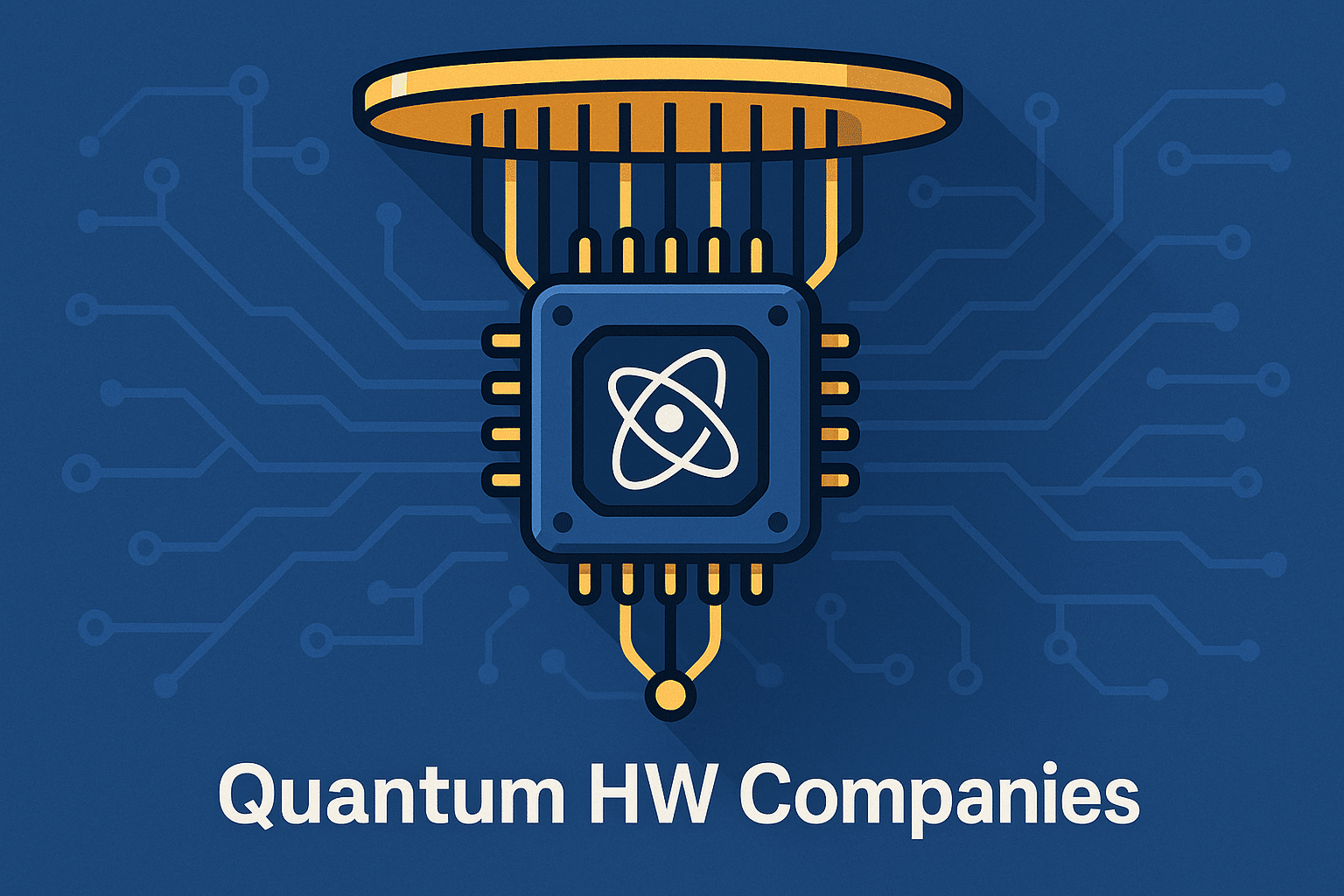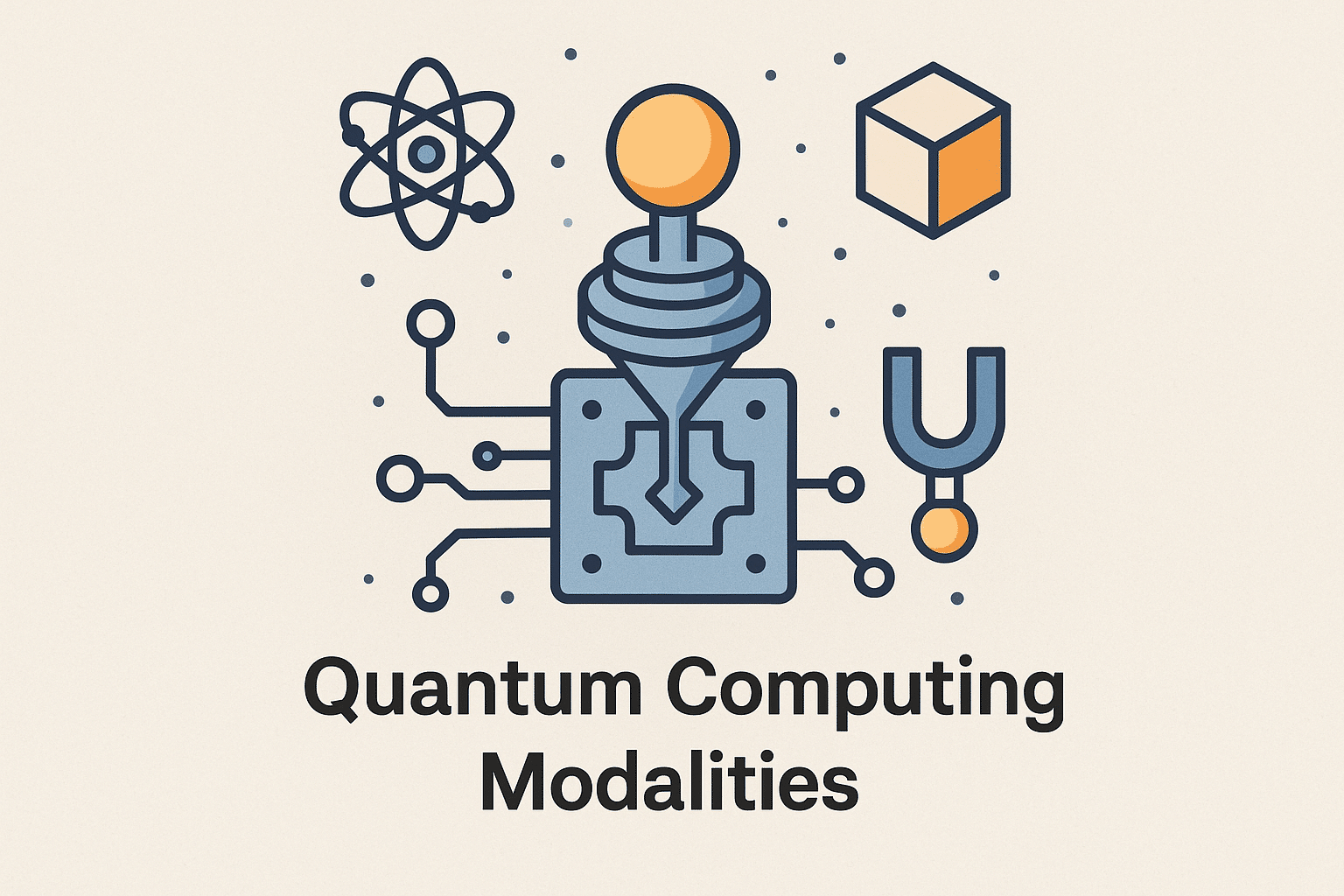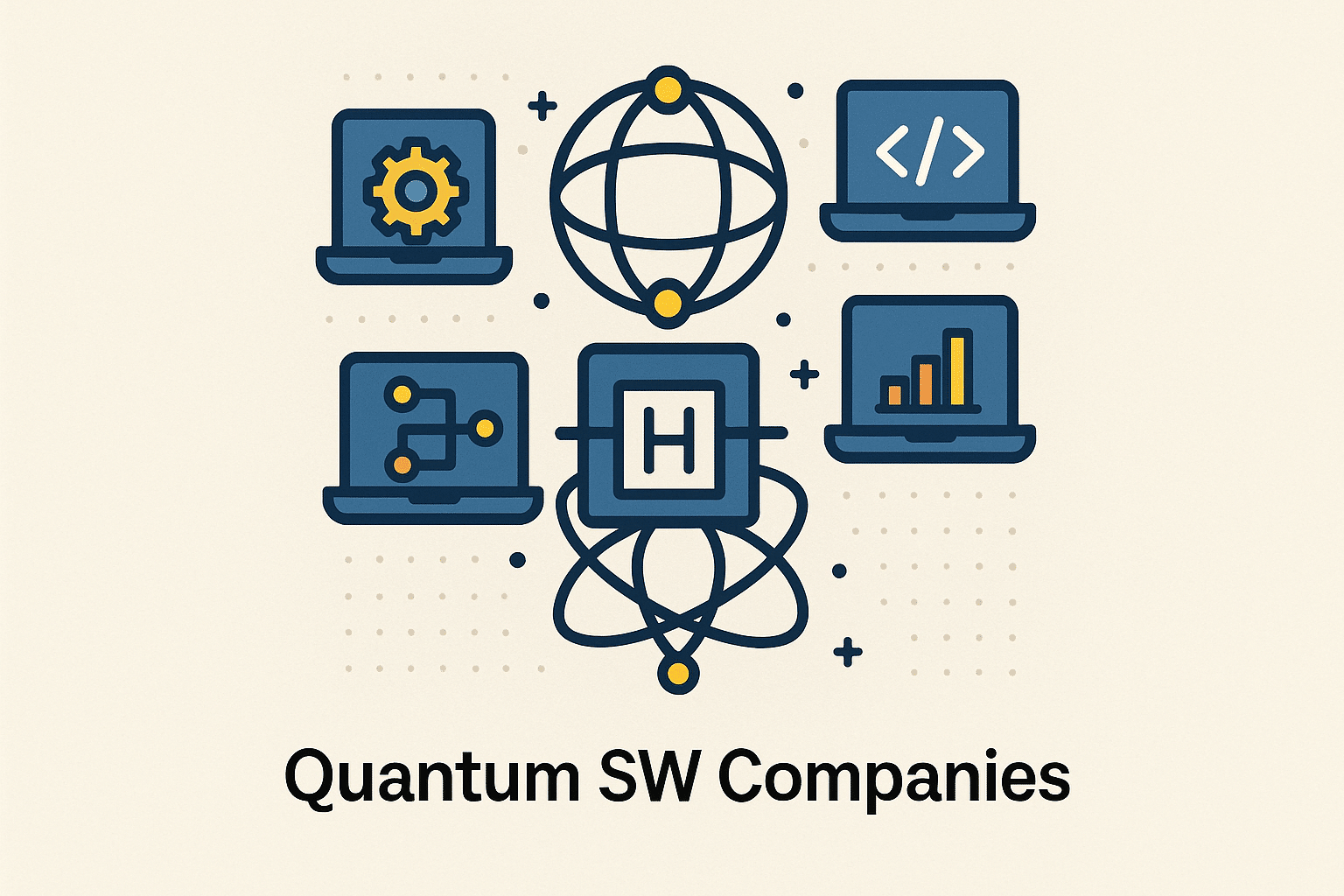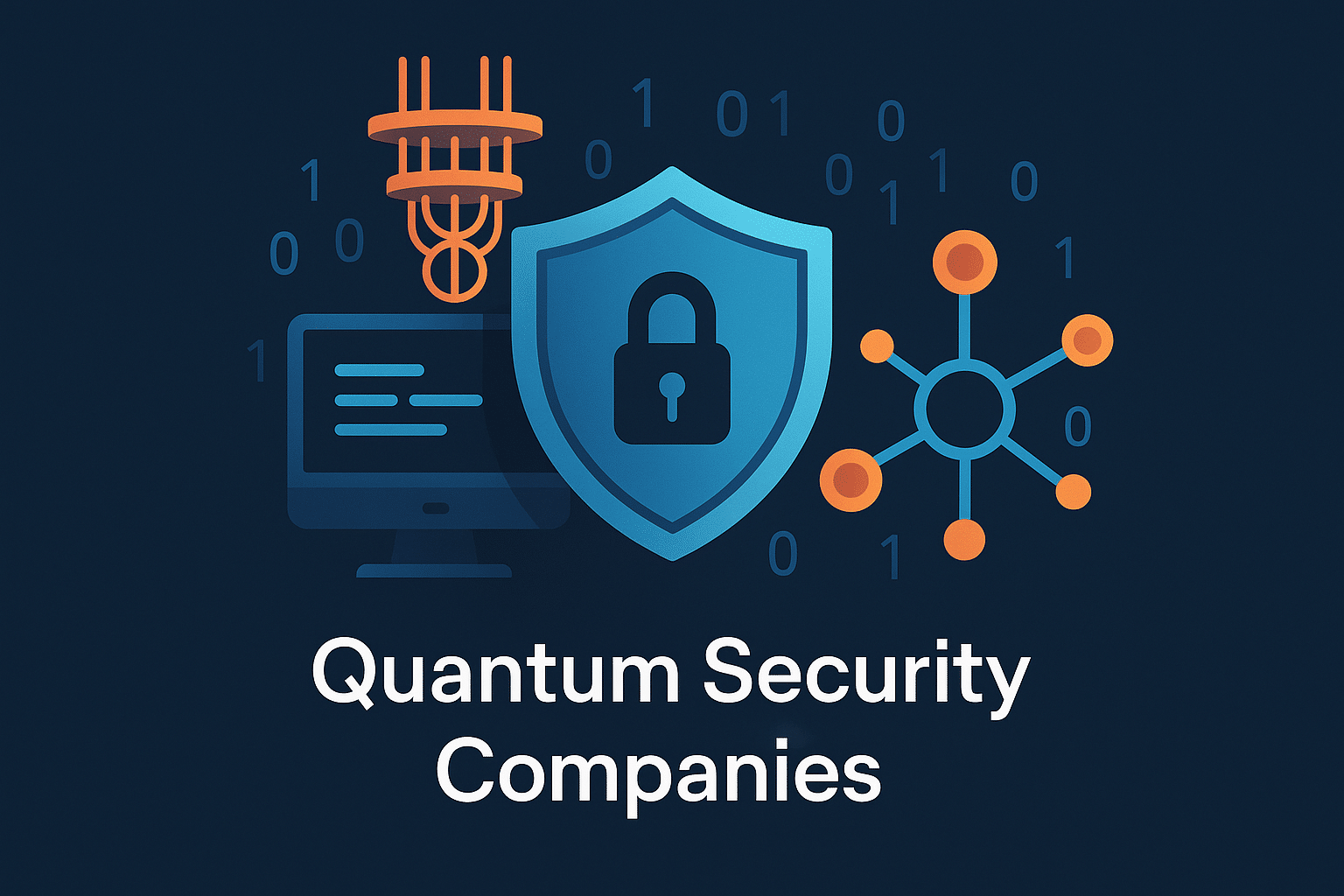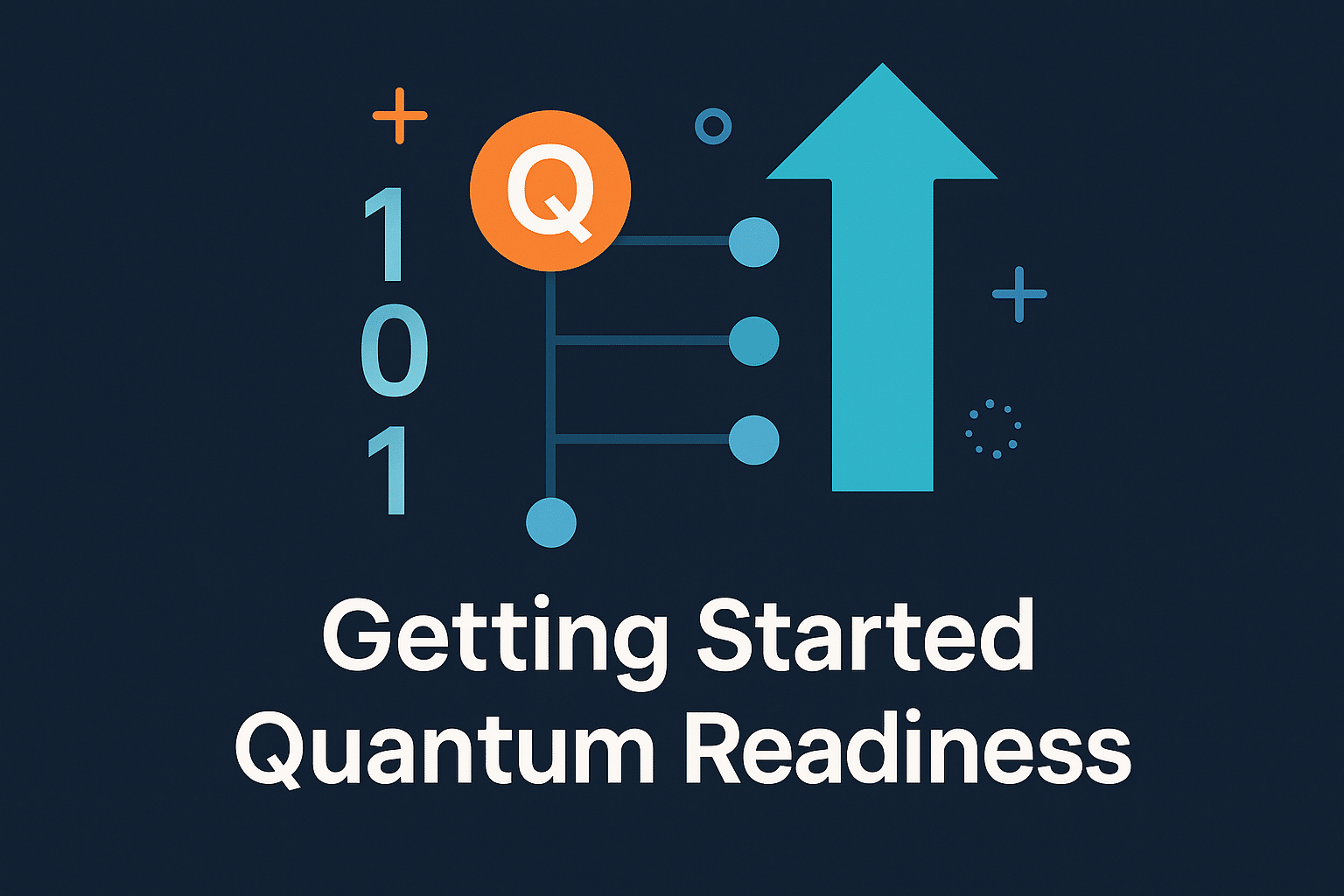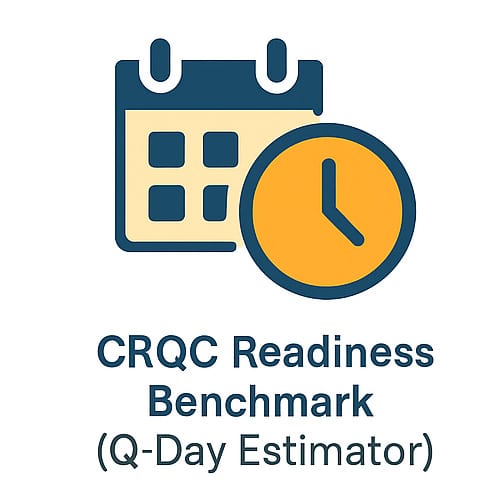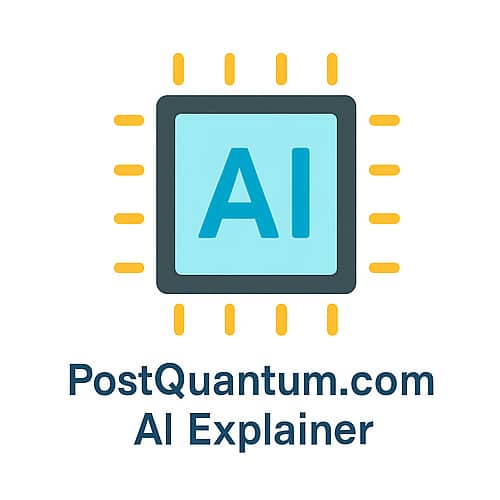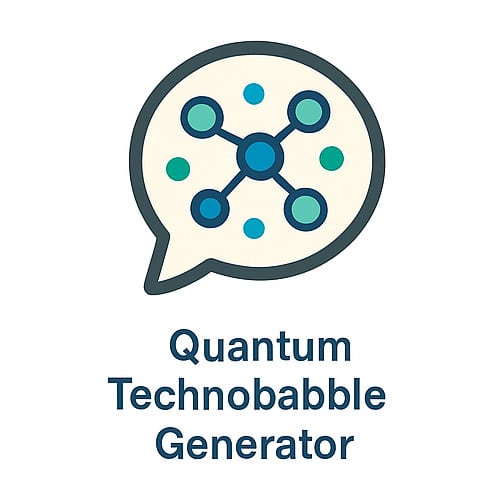Database of Quantum Computing Modalities (2025)
This filterable catalog maps the quantum hardware landscape across gate‑based, measurement‑based, and emerging paradigms/modalities and physical media.
Use the top‑row filters – Category, Physical Medium, Maturity, Operating Temperature, TRL – plus Search and the AND/OR toggle to compare modalities; the icon strip under each card highlights key attributes. Each entry follows a consistent structure (How it works, Advantages, Challenges, Industry Adoption / Key Players, Use Cases, Cybersecurity Impact, Future Outlook) and links out to a full deep‑dive article. Every card links to a detailed article for context, definitions, and sources.
In practice, attributes aren’t always cleanly separated and some modalities straddle categories. Where that happens, I’ve chosen the dominant value that best reflects the modality right now. In my opinion.
Taxonomy & long‑form articles: there’s a broader (and opinionated) taxonomy here: Taxonomy of Quantum Computing: Modalities & Architectures. It also includes links to detailed articles about each category and physical medium.
(Friendly disclaimer: this is my personal, evolving project – not a standard, and not an official classification. No warranties; I try to keep it current, but updates aren’t guaranteed. Use at your own risk, and please flag mistakes or better categorizations.)
Introduction
How It Works
A superconducting transmon is wired as an interdigital transducer or piezoelectric coupler to SAW/HBAR/phononic‑crystal modes, enabling emit/catch of single phonons and Fock‑state control. Recent work demonstrated deterministic phonon phase control and phonon‑number‑resolving detection using interferometry and qubit‑assisted scattering.
Advantages
Loss in acoustic materials/interfaces, two‑level‑system defects, and cryogenic operation limit scale; coupling to qubits can introduce additional dissipation. Current demonstrations operate on small numbers of phonons and components; building large, low‑loss networks with fast feed‑forward is an open engineering challenge.
Challenges
Loss in acoustic materials/interfaces, two‑level‑system defects, and cryogenic operation limit scale; coupling to qubits can introduce additional dissipation. Current demonstrations operate on small numbers of phonons and components; building large, low‑loss networks with fast feed‑forward is an open engineering challenge.
Industry Adoption / Key Players
Activity is led by academic–national‑lab teams (UChicago/Cleland; Yale; Caltech/AWS Center for Quantum Computing; EPFL), with increasing emphasis on manufacturable piezo‑on‑sapphire/Si and high‑coherence HBAR devices. There are no commercial general‑purpose phononic processors yet.
Use Cases
Near‑term roles are quantum memories, on‑chip interconnects, and transduction (e.g., microwave‑to‑optical via optomechanics), plus chip‑scale networking using itinerant SAW phonons for state transfer/entanglement. These aim to offload or connect superconducting processors.
Cybersecurity Impact
Phononic platforms pose no near‑term cryptanalytic threat; only a fault‑tolerant, universal machine would endanger RSA/ECC. This is why agencies are standardizing and urging migration to NIST PQC (FIPS 203/204/205, Aug‑2024) and warning about harvest‑now, decrypt‑later risk.
Future Outlook
Watch for lower‑loss phononic materials/structures, tighter transmon integration, and multi‑mode control (HOM interference, routers) maturing into two‑qubit phonon logic and robust memories. The 2025 phonon phase‑gate + number‑resolving results suggest a path to richer phonon‑native gate sets if coherence and routing continue to improve.
Introduction
AQC encodes the answer to a computation in the ground state of a problem Hamiltonian and adiabatically evolves the system so it remains in that ground state. It strictly generalizes quantum annealing and is computationally equivalent to gate‑based QC.
How It Works
Prepare an easy ground state of H_B, then interpolate H(t)=(1-s(t))H_B+s(t)H_P until H_P dominates; if the evolution is slow relative to the minimum spectral gap g_{\min}, the system ends in (or near) the ground state of H_P. Runtime scales with 1/g_{\min}^2, so small gaps can make the process exponentially slow.
Advantages
Conceptually simple “program by Hamiltonian” approach with a clean physics intuition; and because AQC is universal, any circuit algorithm has an adiabatic form. The Hamiltonian lens also ties directly to complexity theory and optimization mappings.
Challenges
Tiny spectral gaps, analog control precision, and the difficulty of fault‑tolerant error correction in a continuous‑time model are central obstacles. Restricted regimes (e.g., stoquastic Hamiltonians) can be easier to simulate classically, further complicating prospects for advantage.
Industry Adoption / Key Players
There is no commercial universal AQC system; researchers often use annealing hardware as AQC testbeds to explore schedules, suppression, and encodings.
Use Cases
Near‑term, AQC is a design lens for optimization and simulation, informing encodings and heuristics; many NP‑hard problems have Ising/QUBO mappings compatible with adiabatic/annealing hardware. Practical runs today typically occur on annealers or small adiabatic prototypes.
Cybersecurity Impact
Because AQC is universal, a fault‑tolerant AQC machine could run Shor‑class attacks, so the community is migrating to NIST’s 2024 PQC standards (FIPS 203/204/205). Until then, the main security relevance is optimization (defense/planning) rather than near‑term cryptanalysis.
Future Outlook
Expect continued theory on gap engineering, non‑stoquastic paths, and error suppression, plus experimental prototype studies on superconducting platforms and others. The inflection point will be verified large‑gap paths and credible demonstrations of AQC‑native error‑tolerance, not just annealing heuristics.
Introduction
ATQC combines adiabatic quantum computing with topological protection: information is encoded non‑locally in a degenerate ground space, and gates are realized by slow deformations that keep the system in that protected manifold. The aim is intrinsic fault‑tolerance with lower overhead than active QEC.
How It Works
In practice, one engineers a Hamiltonian whose ground space encodes logical qubits (e.g., surface/color‑code models) and then adiabatically deforms the Hamiltonian (moving/merging holes/defects) so the system follows the ground space and implements the desired gate, i.e., adiabatic code deformation. Theory shows this can be done with a gap that remains constant as the computation scales.
Advantages
Topological encoding offers robustness to local errors, and holonomic/adiabatic gates can be insensitive to certain control imperfections. Maintaining a constant spectral gap during deformations suggests a route to hardware‑efficient logical operations.
Challenges
Realizing many‑body Hamiltonians that truly preserve a protective gap while remaining local is experimentally hard; slow adiabatic timescales and fabrication disorder can erode protection. For Majorana‑style realizations, even unambiguous anyon control/braiding and device reproducibility remain open challenges.
Industry Adoption / Key Players
There is no commercial ATQC system. ATQC remains a niche research direction.
Use Cases
Near‑term, ATQC serves as an architecture lens for robust logical gates and state preparation on topological codes, informing how to trade control pulses for protected deformations. Long‑term, its target is universal fault‑tolerant computing with reduced overhead.
Cybersecurity Impact
If ATQC achieves scalable, fault‑tolerant operation sooner than circuit‑QEC, it would accelerate Shor‑class cryptanalysis timelines, reinforcing the need to migrate to NIST’s PQC standards (FIPS 203/204/205, Aug. 2024) now. The prudent posture is to plan for PQC regardless of which universal modality crosses the line first.
Future Outlook
Watch for experimental demonstrations of adiabatic code‑deformation gates on superconducting lattices or verified holonomic operations in topological‑superconductor platforms. Credible progress would show gap preservation, scalable layouts, and integration with measurement‑based primitives where needed.
Introduction
“Digital‑boost” (bang‑bang) annealing replaces a smooth, analog schedule with discrete pulses/quench segments, switching control fields sharply between extremes. The idea bridges analog QA and digitized/optimal‑control insights (e.g., QAOA), seeking speed or robustness on hard instances.
How It Works
Instead of a monotone ramp of the driver B and problem C, the control s(t) jumps between 0 and 1 (or holds plateaus) with optional pause/quench and reverse‑anneal segments. Optimal‑control analyses show hybrids like “bang–anneal–bang” can outperform both pure smooth ramps and pure bang‑bang in finite time.
Advantages
Bang‑bang segments can skip slow, small‑gap regions or exploit diabatic transitions, and hybrid schedules can improve success probability at fixed runtime. The approach inherits QAOA‑style benefits – piecewise‑constant controls that are often provably optimal in restricted settings (Pontryagin)
Challenges
Hardware imposes bandwidth and calibration limits – “perfect bangs” are approximated, not instantaneous; many segments increase sensitivity to control error. Theory also warns that smooth sections may be more robust than pure bang‑bang in noisy settings, so blindly maximizing pulses can backfire.
Industry Adoption / Key Players
D‑Wave exposes pause/quench, reverse annealing, and custom PWL schedules that enable bang‑bang‑like control; white‑papers and docs describe parameterization and use. Research programs explore initial‑state seeding (reverse anneal) and schedule shaping to improve solution quality.
Use Cases
Same targets as QA – QUBO/Ising optimization and sampling – plus scenarios where seeded solutions benefit from local refinement via reverse anneal. In practice, bang‑bang features are used to tune performance on logistics, scheduling, and combinatorial pilots alongside hybrid classical solvers.
Cybersecurity Impact
This modality is not universal and does not threaten RSA/ECC on its own; migrate because of universal gate‑model progress, not annealers.
Future Outlook
Expect better schedule synthesis (auto‑tuned bang–anneal hybrids), clearer robustness results, and tighter integration with hybrid workflows. A practical milestone would be consistent, validated speedups against strong classical baselines on named problem classes using public bang‑bang controls.
Introduction
“Biological QC” spans two ideas: biology as the computer (quantum effects in living systems perform useful information processing) and bio‑inspired hardware (using biomolecules as qubits or scaffolds). The evidence for computation is speculative – intriguing quantum phenomena exist in biology, but none amount to a controllable, general‑purpose computer.
How It Works
Representative mechanisms include excitonic coherence in photosynthetic proteins (e.g., FMO complex) at room temperature, radical‑pair spin chemistry in avian magnetoreception, and phosphorus‑31 nuclear spins protected in Posner molecules as putative “neural qubits.” All are being probed as natural or engineered qubit‑like degrees of freedom, but none provide a programmable, universal model yet.
Advantages
If real and controllable, biology’s glimpses of ambient‑temperature coherence and self‑assembly/repair could inspire quantum hardware that avoids mK fridges and scales via biological fabrication. These systems might also surface new algorithms/principles (e.g., quantum‑walk‑like transport) that differ from mainstream circuit models.
Challenges
The central obstacle is decoherence in warm, wet, noisy media; classic analyses (e.g., Tegmark) argue neural or microtubule coherence would collapse far faster than neurophysiological timescales, with rebuttals still unverified experimentally. Beyond physics, control/readout of in‑vivo quantum states and reproducibility across biological units are severe engineering hurdles.
Industry Adoption / Key Players
There is no commercial biological QC effort; activity is academic and exploratory (quantum biology labs; Fisher’s “quantum brain” collaborations testing Posner‑spin hypotheses). Big‑tech interest is limited to sponsoring workshops or adjacent quantum‑biology research rather than product roadmaps.
Use Cases
Near‑term value is scientific: probing quantum effects in biology, bio‑inspired device engineering (e.g., DNA origami to position conventional qubits), and quantum sensing in/for biology (e.g., NV‑center magnetometry interfaced with biomolecules). These inform materials, architectures, and metrology – not end‑user computing.
Cybersecurity Impact
None today. If a fault‑tolerant biological QC ever existed, it would pose the same Shor‑class risks as other universal platforms – hence the push to PQC (NIST FIPS 203/204/205, Aug‑2024) – but that is far beyond current evidence. Organizations should continue PQC migration for HNDL risk independent of this modality’s speculation.
Future Outlook
Pivotal milestones would include unambiguous, long‑lived entanglement in biomolecular systems, controllable qubit operations (init/control/readout), and a credible architecture (even niche) that shows programmability. Theory (e.g., Posner‑spin computation) offers scaffolds, but the near‑term trajectory is verification science, not productization.
Introduction
Boson sampling asks a photonic device to draw samples from a probability distribution that arises when many identical photons interfere in a passive network. The task is believed to be classically intractable at scale, making it a leading vehicle for demonstrating quantum advantage without universality.
How It Works
Inputs are Fock states (or squeezed states for Gaussian boson sampling) injected into an m-mode interferometer; output click‑patterns are recorded by photon‑number‑resolving detectors. The distribution depends on matrix permanents (standard BS) or hafnians (GBS), which underpin the hardness guarantees.
Advantages
It avoids full‑stack qubit control while still reaching computational regimes out of classical reach (e.g., Jiuzhang, Borealis). Time‑multiplexing and integrated photonics allow large‑mode experiments with dynamic programmability.
Challenges
Performance is acutely sensitive to loss, source indistinguishability, and detector efficiency; verification must defeat spoofing by clever classical heuristics. The model is non‑universal and lacks an obvious, broad “killer app.”
Industry Adoption / Key Players
USTC (photonic advantage with Jiuzhang) and Xanadu (Nature 2022 advantage with Borealis) lead high‑profile demos; Quandela provides cloud‑connected photonic hardware and tooling (Perceval). Industrial activity centers on platforms and software rather than dedicated boson‑sampling appliances.
Use Cases
Explored applications include molecular vibronic spectra and graph problems (e.g., densest‑k‑subgraph) via Gaussian boson sampling; early experiments and simulations show promise but also mixed evidence versus advanced classical methods. It remains a niche accelerator rather than a general solver.
Cybersecurity Impact
Boson sampling does not endanger RSA/ECC (it’s not a universal computer), but it’s been proposed for quantum‑certified randomness and even boson‑sampling‑based cryptographic primitives/PUFs—still research‑stage ideas. Standard PQC migration remains the right response to future universal quantum threats.
Future Outlook
Expect larger, better‑validated experiments (lower loss, stronger verification) and more integrated photonics with programmable time‑/space‑multiplexing. The yardstick will be robust advantage and a few compelling domain tasks where GBS consistently assists or outperforms classical pipelines.
Introduction
Dissipative quantum computing leverages open‑system dynamics – intentionally coupling qubits to engineered environments – so that relaxation drives the system into a unique steady state that encodes the answer. It reframes “noise” as a tool for state preparation and stabilization.
How It Works
The evolution is governed by a Lindblad master equation with carefully chosen “jump” operators; the steady state of this Liouvillian is designed to be the computation’s output. Experiments have realized the essential toolbox by combining unitary gates and optical pumping in trapped ions, and by reservoir engineering in superconducting circuits.
Advantages
DQC can stabilize fragile entangled states and prepare complex resources (e.g., PEPS, topologically ordered states) in a way that is naturally robust to certain errors. In principle it may reduce error‑correction overhead by baking protection into the dynamics via engineered dissipation.
Challenges
Scaling requires precise Liouvillian engineering and sufficiently large Liouvillian gaps; small gaps can make convergence slow. Theory shows dissipative models are not more powerful than circuits under reasonable assumptions, and practical blueprints for large, programmable DQC hardware are still missing.
Industry Adoption / Key Players
There is no commercial DQC system today. Academic groups have led milestones, e.g., Barreiro et al. (2011) on ions, and circuit‑QED teams demonstrate dissipative stabilization and entanglement via reservoir engineering.
Use Cases
Near‑term value is state engineering and autonomous stabilization (e.g., Bell/cat states), open‑system simulation, and exploring dissipative QEC primitives. These are being used as building blocks and calibration tools within ion‑trap and superconducting research platforms.
Cybersecurity Impact
If scaled to fault‑tolerant sizes, DQC would run the same cryptanalytic algorithms (e.g., Shor) as circuit‑based QC – another reason organizations are migrating to NIST’s PQC standards (FIPS 203/204/205, Aug 13, 2024). Until then, DQC poses no distinct near‑term crypto threat beyond universal QC’s trajectory.
Future Outlook
Expect hybridization – gate‑based processors augmented with dissipative stabilization or state‑prep modules – and clearer links between Liouvillian gaps and algorithmic complexity. Progress will be measured by larger, verified dissipative resources and practical, low‑overhead primitives that integrate into mainstream stacks.
Introduction
DNA‑based Quantum Information Processing (QIP) explores DNA as a qubit host, a coupling/interface, or a programmable nanoscale scaffold to place quantum components with nm‑precision. It sits at the intersection of quantum tech and DNA nanotechnology/origami, with most credible near‑term roles on the scaffolding/integration side.
How It Works
Paths include nuclear/electron spins in or on DNA (e.g., ^31P in proposed Posner molecules), and DNA‑origami to deterministically place quantum dots, color centers, or spins for photonic/spin‑based devices. Recent work shows DNA‑programmed spin arrays sensed by NV centers and DNA‑assembled photonic crystals/single‑emitter configurations.
Advantages
DNA offers nm‑scale placement and bottom‑up mass self‑assembly, potentially enabling dense, low‑cost integration that’s difficult with top‑down lithography. As a scaffold, it can bridge to biological interfaces and precision photonics/spin architectures.
Challenges
Core issues are decoherence in wet/thermal environments, lack of individual‑state control/readout in DNA, assembly variability, and integration with cryo/optical/microwave stacks. Even “precise” origami placement has error bars that matter at quantum‑coupling scales.
Industry Adoption / Key Players
There are no dedicated DNA‑QC vendors; activity is largely academic (DNA‑origami/nanophotonics groups; molecular‑spin chemistry; NV‑sensing of DNA‑patterned spins). There are no DNA‑QC startups.
Use Cases
Near‑term value is enabling: deterministic placement of emitters/spins, hybrid photonic structures, and quantum sensing at bio‑interfaces – not universal computing. DNA‑assembled photonic lattices and emitter arrays illustrate the integration potential.
Cybersecurity Impact
None today. If a DNA‑based universal platform ever emerged, it would pose the same Shor‑class risks as other modalities; this is why NIST finalized PQC (FIPS 203/204/205, Aug‑2024) and urges migration to mitigate harvest‑now‑decrypt‑later.
Future Outlook
Watch DNA‑templated device integration (emitters/spins with controlled orientation/gaps), reproducible molecular‑spin control, and credible gate demonstrations. In the nearer term, expect more results where DNA enables quantum photonics/spin networks rather than constituting a standalone modality.
Introduction
Fibonacci anyons are the simplest non‑Abelian anyon model whose braids are dense in SU(2), enabling universal topological computation. Information lives non‑locally in the fusion space, promising inherent robustness to local noise.
How It Works
Qubits are encoded in the fusion space of τ anyons (with fusion rule τ×τ = 1 + τ); braiding implements unitary gates, and readout uses fusion outcomes. In contrast to Ising/Majorana schemes, no non‑topological magic‑state injection is required for universality.
Advantages
If realized, Fibonacci anyons could combine topological protection with universal braiding, potentially reducing error‑correction overhead versus non‑topological qubits or Ising‑anyon approaches. Theoretical compilers exist to synthesize gate sets directly from braid words.
Challenges
The existence and controllable realization of Fibonacci phases remain unproven; ν = 12/5 FQH evidence is inconclusive, and parafermion‑based heterostructures are still proposals. Even with a host material, reliable creation, motion/braiding, and readout of individual anyons will be technically demanding.
Industry Adoption / Key Players
No commercial hardware targets Fibonacci anyons today; activity is academic/theoretical, with proposals such as bilayer FQH or QH–superconductor architectures to engineer parafermions that yield a Fibonacci phase. (Examples include Vaezi & Barkeshli and related PRL/PRX blueprints.)
Use Cases
Near‑term “use” is research: materials discovery, verification protocols, and simulations of Fibonacci models on conventional quantum processors. Long‑term, a Fibonacci platform would be a universal, fault‑tolerant topological computer by braiding alone.
Cybersecurity Impact
At scale, a Fibonacci‑anyon computer could run Shor‑class cryptanalysis like any universal platform, which is why NIST finalized PQC standards (FIPS 203/204/205, Aug‑2024) and urges migration to quantum‑safe schemes. Given today’s TRL, this is strategic – not immediate – but harvest‑now, decrypt‑later risks apply.
Future Outlook
Key milestones are unambiguous detection of a Fibonacci phase (e.g., at ν = 12/5) and/or engineered parafermion networks that realize it, followed by demonstration of braiding and fusion with high fidelity. Until then, expect continued theory, materials advances, and digital simulations that test braiding rules and compilation strategies.
Introduction
Holonomic (geometric‑phase) QC performs logic by steering a quantum system around closed loops in parameter space so the state acquires a geometric phase/holonomy that realizes a gate. The approach began with adiabatic holonomies and now includes non‑adiabatic versions designed for speed on short‑coherence hardware.
How It Works
Practical schemes use three‑level (Λ‑type) manifolds to accumulate non‑Abelian phases that enact single‑ and two‑qubit gates; the transformation depends only on the path, not the rate, of control. Landmark experiments include non‑adiabatic holonomic gates in superconducting circuits and trapped‑ion realizations with optimal control.
Advantages
Because gate action is geometric, holonomic operations can be intrinsically insensitive to certain pulse‑shape and timing errors, offering robustness to control imperfections. Non‑adiabatic protocols aim to marry that robustness with speed, improving tolerance to decoherence.
Challenges
Many schemes require ancillary levels whose population increases sensitivity to decoherence/leakage; ensuring robustness under realistic noise remains non‑trivial. Scaling high‑fidelity two‑qubit holonomic gates and integrating them into full compilers/calibration stacks is an open engineering task.
Industry Adoption / Key Players
Adoption is research‑led: superconducting‑circuit demonstrations (e.g., ETH/PSI collaborators) established non‑Abelian geometric gates; trapped‑ion groups have realized non‑adiabatic holonomic gates; NV‑center labs explore holonomic control in solids. No vendor markets a holonomic‑first processor today.
Use Cases
Near‑term, holonomic gates serve as robust primitives in testbeds – comparative studies of control‑error resilience, state preparation, and as ingredients in error‑suppression pipelines. They are also a clean platform for quantum‑control benchmarking against dynamical gates.
Cybersecurity Impact
Holonomic QC is a control paradigm for universal machines; at fault‑tolerant scale it would run the same Shor‑class cryptanalysis as other universal modalities. Hence the ongoing migration to NIST’s PQC standards remains the relevant defensive action.
Future Outlook
Watch for high‑fidelity two‑qubit holonomic gates integrated into standard control stacks and demonstrations that retain geometric robustness at scale. If those milestones land, holonomic control could become a drop‑in option for SC/ion platforms where pulse robustness and calibration stability are bottlenecks.
Introduction
Ion‑trap / neutral‑atom MBQC implements universal quantum computing by preparing an entangled resource (cluster state) on matter qubits and then computing solely via adaptive measurements. It offers an alternative execution model to gate‑by‑gate control and is a natural fit wherever measurements are high‑fidelity and controllable.
How It Works
In ions, multi‑ion gates generate a cluster/graph state; the algorithm is encoded by a sequence of single‑ion measurements whose bases depend on earlier outcomes (feed‑forward). Neutral‑atom versions aim to generate 1D/2D cluster states using Rydberg interactions before running the same measurement‑driven computation.
Advantages
MBQC can leverage platforms with excellent measurement/readout and supports verification/blind‑computing protocols naturally. In ions, recent work showed verifiable MBQC sampling; the model also aligns with error‑correction blueprints based on 2D/3D cluster states.
Challenges
Key bottlenecks are loss/overhead in resource‑state generation, fast, low‑latency feed‑forward, and measurement crosstalk – especially as cluster sizes grow. Neutral‑atom MBQC additionally needs scalable, high‑fidelity cluster factories with low loss and uniform control.
Industry Adoption / Key Players
Innsbruck/IQOQI led trapped‑ion MBQC milestones (2013 cluster‑state QC; 2024/25 verifiable sampling). Oxford demonstrated verifiable blind quantum computing with an ion‑trap server and photonic client; neutral‑atom groups (e.g., QuEra/Harvard/MPI) explore cluster‑state benchmarking on large arrays.
Use Cases
Near‑term MBQC showcases include verifiable sampling, blind/verifiable QC, and measurement‑based QEC primitives on small cluster states. These demos validate MBQC’s strengths in security/verification and inform scaling paths for ions/atoms.
Cybersecurity Impact
At fault‑tolerant scale, MBQC on ions/atoms could run Shor‑class attacks like any universal platform – hence NIST’s finalized PQC standards (FIPS 203/204/205, Aug‑2024) and migration guidance. MBQC also enables privacy‑preserving primitives (e.g., blind QC) that support secure quantum clouds.
Future Outlook
Expect bigger, verified cluster states on ions via modular architectures and photonic interconnects, and maturing neutral‑atom cluster factories if loss and control improve. The next milestones are MBQC logical primitives (with error suppression) and practical blind/verified workflows on 10s–100s of physical qubits.
Introduction
Quantum LDPC codes use sparse stabilizers to keep check weight and qubit degree constant, reducing overheads. Combining them with cluster states (via foliation or related constructions) yields a measurement‑based route to fault tolerance that can capitalize on photonics’ ability to build huge entangled resources.
How It Works
Choose a CSS/qLDPC code and map it to a graph/cluster; prepare the cluster (often from small resource states via fusions), then execute the algorithm and error correction by measuring qubits in prescribed bases with classical feed‑forward. This subsumes surface‑code RHG‑style 3D clusters and generalizes to LDPC families.
Advantages
LDPCs promise finite rate and low check weight, enabling lower‑overhead fault tolerance than surface‑code baselines; cluster/FBQC constructions match natural photonic primitives (entangling measurements). Modular photonic chips and time‑multiplexing scale the resource factory.
Challenges
Resource factories must beat loss and deliver fast feed‑forward; robust non‑Gaussian elements and low‑error entangling measurements remain bottlenecks. Decoders for qLDPC in foliated/cluster form must handle realistic noise (loss + dephasing) efficiently at scale.
Industry Adoption / Key Players
Adoption is research‑led: fusion‑based MBQC (Bartolucci et al.), 1D/branched cluster proposals at high threshold, and all‑photonic MBEC for repeaters that accept CSS/qLDPC codes. Photonic groups have also shown multi‑chip modular cluster‑state prototypes.
Use Cases
Near‑term: fault‑tolerant resource generation (topological or LDPC cluster states), photonic repeaters with MBEC over qLDPC/CSS, and validation of fusion‑networks on integrated photonics. Long‑term: universal MBQC with qLDPC‑protected logical qubits for simulation, chemistry, and algorithms.
Cybersecurity Impact
At scale, an LDPC‑protected MBQC machine would run Shor‑class cryptanalysis like any universal platform, which is why agencies finalized NIST PQC (FIPS 203/204/205) and stress HNDL risk. The modality doesn’t change the threat model – only the timeline if it accelerates fault tolerance.
Future Outlook
Watch for hardware‑efficient qLDPC implementations in MBQC (single‑shot prep, constant‑gap deformations) and better decoders integrated with fusion networks. Photonic progress – lower loss, scalable detectors, and verified large clusters – will determine when LDPC‑cluster schemes cross into logical‑qubit demonstrations.
Introduction
Majorana qubits encode information non‑locally in pairs of Majorana zero modes, promising intrinsic protection from local noise. They are central to the vision of topological quantum computing, but remain unproven as a practical modality.
How It Works
Hybrid devices (e.g., InAs/InSb nanowires + Al superconductors) or TI/superconductor interfaces are tuned into a topological phase that hosts spatially separated Majoranas. Logic would be implemented by braiding these anyons, whose gate action depends only on the topology of the exchange path.
Advantages
If realized, topological protection could suppress many local error channels and dramatically reduce error‑correction overhead. Because gates depend on braid topology, they are in principle robust to analog control imperfections.
Challenges
Unambiguous creation and manipulation of Majoranas is technically and scientifically fraught (cf. the 2018 Nature claim later retracted; continuing debates about “gap” protocols and device interpretation). Demonstrating braiding on physical devices and reproducible qubit operations remains an open milestone.
Industry Adoption / Key Players
Microsoft/Station Q and QuTech (TU Delft) lead large programs; QuTech reported a 2D platform that could enable braiding geometries, while Microsoft’s “topological‑gap” results sparked both excitement and criticism. There are no commercial topological‑qubit systems available today.
Use Cases
Near‑term “use” is research‑centric: materials growth, device physics, and verification protocols (gap spectroscopy, fusion‑rule tests) rather than applications. Long‑term, a fault‑tolerant topological processor would target the full set of universal QC workloads.
Cybersecurity Impact
At scale, a topological computer would run Shor‑class cryptanalysis like any universal platform, threatening RSA/ECC—one driver behind NIST’s 2024 PQC standards and “harvest‑now, decrypt‑later” warnings. The modality’s current TRL means the threat is not immediate but is strategically relevant.
Future Outlook
Watch for verified braiding/fusion in solid‑state devices and reproducible logical‑qubit primitives; progress in 2D/planar platforms could be pivotal. Until then, expect continued contention around evidence standards and incremental materials/device advances.
Introduction
Neuromorphic quantum computing aims to physically implement neural‑network computation on quantum hardware, marrying the adaptive learning of neuromorphic systems with quantum superposition/entanglement. It is framed as an alternative execution model to standard gate computers, not merely “ML on a quantum processor.”
How It Works
Three pillars dominate: (i) parameterized quantum neural networks (variational circuits trained like NNs); (ii) synaptic quantum elements (e.g., quantum memristors) that add history‑dependent nonlinearity; and (iii) quantum reservoir computing that exploits rich many‑body dynamics with simple classical read‑out. Each has credible theory and early experiments.
Advantages
NQC can leverage the high‑dimensional Hilbert space of quantum systems for compact, trainable models and may enable learning‑oriented quantum advantage on time‑series and pattern tasks. Reservoir approaches show that few‑qubit systems can match large classical recurrent nets on benchmarks – suggesting strong compute–to–capability ratios if noise is tamed.
Challenges
Scaling requires hardware with plasticity (memristive/tunable couplers) that doesn’t kill coherence; multi‑element quantum‑memristor networks remain technically hard. Verification of true advantage and robust training under decoherence/feedback is open, and there’s no consensus universal NQC architecture yet.
Industry Adoption / Key Players
There is no commercial NQC processor today. The Quromorphic consortium targets superconducting quantum neural hardware, while academic/industrial photonics groups (Vienna/Milan et al.) demonstrated the first quantum memristor on‑chip; CNRS‑Thales and collaborators pursue SC‑based QNN experiments.
Use Cases
Near‑term focus is state preparation, control/optimization, and time‑series modeling via quantum reservoirs (including applications explored in finance). Longer term, NQC is positioned as a learning‑centric accelerator complementing universal machines.
Cybersecurity Impact
NQC does not introduce a new cryptanalytic pathway beyond universal QC; if a large‑scale NQC machine existed, it would still rely on universal quantum algorithms (e.g., Shor) to threaten RSA/ECC. Hence the migration to NIST’s PQC standards (FIPS 203/204/205; Aug 13–14, 2024) remains the right control for HNDL risk.
Future Outlook
Watch for small networks of quantum memristors and 10–20‑qubit QNN/Reservoir demos that show compelling, verified tasks; parallel work will push superconducting platforms (cryo‑compatible “synapses”) and integrated photonics (low‑loss, feedback‑ready chips). A meaningful inflection would be end‑to‑end learning on quantum hardware with reproducible gains over classical baselines.
Introduction
Neutral‑atom processors use reconfigurable optical tweezer arrays to hold hundreds of atoms that serve as qubits, controlled by lasers or microwaves. The approach blends long coherence with flexible connectivity and has moved from small lab demos to cloud/testbed access over the last few years.
How It Works
Atoms are trapped and laser‑cooled in tweezers; two hyperfine ground states encode |0⟩, |1⟩. Entangling CZ/CNOT gates arise from Rydberg blockade (exciting one atom shifts its neighbor), and readout uses state‑dependent fluorescence – standard circuit‑QED‑like control but in the optical domain.
Advantages
Arrays are reconfigurable (move atoms, redraw connectivity) and can support parallel operations; within a blockade radius, connectivity can be effectively any‑to‑any. Long‑lived ground‑state qubits and room‑temp apparatus ease scaling and integration.
Challenges
Two‑qubit gate speed (µs‑scale) and uniform high‑fidelity control across large arrays remain difficult, with laser stability, atomic motion, and optical crosstalk as key pain points. Scaling also demands integrated optics, low‑loss interconnects, and fast feed‑forward to manage large cluster/gate workloads.
Industry Adoption / Key Players
QuEra provides a 256‑atom AHS system on AWS Braket; Pasqal has delivered neutral‑atom QPUs to European HPC centers and expanded cloud access (e.g., Azure). Atom Computing reported a 1,180‑qubit array (universal platform), and Infleqtion has presented high‑fidelity gate results toward fault tolerance.
Use Cases
Near‑term strengths include analog many‑body simulation (Ising‑type models) and combinatorial optimization mapped to Rydberg interactions; these are already exposed via cloud/testbeds. Early digital demonstrations target VQE‑style chemistry and small algorithmic benchmarks on few‑ to few‑dozen‑qubit arrays.
Cybersecurity Impact
At fault‑tolerant scale, neutral‑atom machines would run Shor‑class attacks like any universal platform, threatening RSA/ECC. This is why NIST finalized the first PQC standards (FIPS 203/204/205) in 2024 and warns about harvest‑now‑decrypt‑later, motivating migration planning now.
Future Outlook
Expect bigger, more uniform arrays; continued fidelity gains (building on 99.5% CZ) and photonic interconnects for modular scaling. If control stacks and optics integration mature, neutral atoms could become a top contender for early logical qubits and domain‑specific advantage in simulation.
Introduction
The One‑Clean‑Qubit (DQC1) model asks how much computation is possible when only one qubit is pure and the rest of the register is maximally mixed – a scenario originally motivated by NMR. Despite the extreme mixedness, DQC1 can solve certain tasks efficiently that lack known classical algorithms
How It Works
A typical DQC1 circuit prepares the clean qubit, applies a Hadamard, then a controlled‑U acting on the mixed register, and finally measures the clean qubit in X/Y. Repeating the run estimates the normalized trace of U (real/imaginary parts), the core primitive behind many DQC1 applications.
Advantages
DQC1 tolerates highly mixed qubits, making it natural for platforms where full purification is costly. Experiments show quantum advantage mechanisms without entanglement, with quantum discord proposed as the enabling resource; complexity results indicate classical simulation would collapse the polynomial hierarchy under plausible assumptions.
Challenges
The model is non‑universal and yields only one‑bit readout per run, so algorithm design is narrow and verification subtle. Certain “zero‑discord” cases admit efficient classical simulation, and mapping broadly useful problems to trace‑estimation primitives remains an active research area.
Industry Adoption / Key Players
Adoption is research‑led: seminal all‑optical experiments validated the model; NMR realized DQC1 algorithms like Jones polynomial estimation; recent studies implemented DQC1‑style workloads on IBM superconducting hardware for benchmarking/ML. No vendor markets a DQC1‑first processor.
Use Cases
Canonical tasks include normalized‑trace estimation and knot invariant (Jones polynomial) approximations; both highlight the model’s sampling power from limited purity. Practically, DQC1 is used as a benchmarking and learning (kernel) primitive on today’s devices.
Cybersecurity Impact
DQC1 does not threaten RSA/ECC by itself – it’s not a universal computer – so it isn’t a near‑term cryptanalytic risk.
Future Outlook
Expect DQC1 to continue as a workhorse testbed for mixed‑state resources (coherence ↔ discord conversion) and as a compact benchmark across modalities. Watch for broader photonic/SC demonstrations (and exploratory neutral‑atom work) that tie DQC1 primitives to verification and ML pipelines.
Introduction
Photonic quantum computing uses single photons or optical modes as information carriers, leveraging low decoherence and telecom‑grade photonics to route and interfere qubits. The approach has surged since KLM’s 2001 result and MBQC/cluster‑state proposals, with industry pursuing scalable silicon‑photonics implementations. (Also discusses MBQC; see dedicated ‘Photonic Cluster‑State’ entry for one‑way model.)
How It Works
In discrete‑variable (single‑photon) schemes, entanglement and logic are realized by linear optics plus measurement‑induced nonlinearity (KLM) or by preparing a large cluster state and consuming it via measurements (MBQC). Continuous‑variable routes (squeezed light) generate time‑multiplexed cluster states with programmable Gaussian operations and non‑Gaussian measurements.
Advantages
Photonic processors can operate near room temperature, integrate with mature silicon photonics, and network naturally over fiber—attractive for modular scaling. They also support high clock rates and massively parallel mode architectures, evidenced by large‑mode GBS experiments.
Challenges
The central hurdles are loss and the probabilistic nature of two‑photon entangling operations, which drive huge overheads for large cluster states and fault tolerance. High‑efficiency sources/detectors, ultra‑low‑loss interconnects, and fast feed‑forward must all improve in lockstep.
Industry Adoption / Key Players
PsiQuantum (silicon‑photonics, fusion‑based MBQC) has deep‑foundry partnerships and announced large facilities in Australia/US; Xanadu demonstrated a programmable GBS machine (Borealis) with published advantage; Quandela offers photonic QPUs via cloud; and ORCA Computing has delivered room‑temperature photonic systems to the UK MoD and the UK NQCC.
Use Cases
Near‑term photonic computers excel at Gaussian Boson Sampling (GBS), with applications explored in molecular vibronic spectra and graph problems (e.g., densest‑k‑subgraph, clique). These are not yet general‑purpose wins, but they showcase photonics’ sampling power and inform algorithm‑hardware co‑design.
Cybersecurity Impact
A fault‑tolerant photonic computer would run Shor‑class attacks like any universal platform, so the community is moving to PQC (NIST’s final FIPS 203/204/205 in Aug‑2024). Until migration is complete, harvest‑now‑decrypt‑later remains a strategic risk for long‑lived data.
Future Outlook
Roadmaps emphasize manufacturable silicon‑photonics, fusion‑based MBQC, and time‑multiplexed cluster states, with growing efforts to network many photonic chips into modular systems. Expect continued advantage‑style demonstrations, testbeds in data centers, and first steps toward logical qubits if loss and detector/source performance continue to improve.
Introduction
Photonic cluster‑state computing is a measurement‑driven approach: prepare a highly entangled photonic resource (the cluster), then compute solely by single‑photon measurements with feed‑forward. It’s a focused subset of photonic QC, contrasted with gate‑based LOQC and other photonic schemes.
How It Works
Small entangled photonic states are created (e.g., from SPDC or quantum‑dot sources) and “fused” into large graph/cluster states; computation is realized by choosing measurement bases and updating them adaptively from earlier outcomes. “Fusion‑based QC” formalizes resource‑efficient MBQC tailored to photonics.
Advantages
Photonic hardware can run near room temperature, is native to fiber networking, and supports high‑rate, massively parallel mode‑multiplexing. CV experiments have generated huge cluster states (10⁴–10⁶ modes), underscoring scalability of the resource‑generation step.
Challenges
Key bottlenecks are loss, probabilistic entanglement/fusion, and low‑latency feed‑forward, which together drive overhead for fault tolerance. Improving bright indistinguishable sources, ultra‑low‑loss photonics, and fast control/detection is central to progress.
Industry Adoption / Key Players
PsiQuantum pursues silicon‑photonics, fusion‑based MBQC at scale and is building large test systems; Xanadu advances time‑multiplexed CV cluster states and demonstrated photonic “advantage” (Borealis) while pushing toward universal machines (Aurora). Quandela develops on‑chip single‑photon platforms and publishes cluster‑state building blocks.
Use Cases
Near‑term efforts center on resource‑state generation/verification, small MBQC circuits, and photonic networking primitives; CV/DV cluster states also inform error‑correction experiments. All‑photonic repeater proposals use cluster states for long‑distance, loss‑tolerant entanglement distribution.
Cybersecurity Impact
At fault‑tolerant scale, MBQC photonic machines could run Shor‑class cryptanalysis like other universal platforms, motivating migration to NIST’s 2024 PQC standards (FIPS 203/204/205). Meanwhile, photonic cluster states bolster quantum‑network security primitives (e.g., device‑independent QKD, blind QC).
Future Outlook
Roadmaps emphasize fusion‑based architectures, manufacturable silicon photonics, and time‑multiplexed cluster factories, with milestones toward logical qubits as losses and detector/source performance improve. Expect continued testbeds, growing cluster sizes, and the first MBQC demonstrations with integrated error‑correction features.
Introduction
Photonic Continuous-Variable Quantum Computing (CVQC) encodes quantum information in continuous variables (field quadratures) rather than two‑level qubits, leveraging mature quantum‑optics tooling (squeezers, beam splitters, homodyne). The approach promises deterministic, ultra‑large entangled resources via Gaussian operations plus a non‑Gaussian spark for universality.
How It Works
Large Gaussian cluster states are built from squeezed modes interfered in time/space; computation proceeds by sequential homodyne measurements and classical feed‑forward. Universality demands a non‑Gaussian gate or measurement (e.g., cubic‑phase resource or photon counting) injected into that flow.
Advantages
Photonic hardware enables deterministic, scalable entanglement (thousands–millions of modes) via time‑multiplexing, and many operations run at room temperature. CV architectures dovetail with bosonic error correction (e.g., GKP codes) and have shown computational advantage in Gaussian‑boson‑sampling tasks.
Challenges
Purely Gaussian stacks are classically simulable, so robust non‑Gaussian resources are the bottleneck. Fault tolerance requires high squeezing – historically ~20.5 dB, improved to ~12.7 dB with surface‑GKP architectures – still beyond routine lab operation.
Industry Adoption / Key Players
Xanadu demonstrated programmable photonic advantage (Borealis) and leads CV software tooling (e.g., Strawberry Fields); mega‑mode CV clusters were pioneered by Tokyo and Copenhagen groups. Broader efforts focus on integrated photonics and detector stacks rather than turnkey universal CVQC.
Use Cases
Near‑term: Gaussian boson sampling for molecular vibronic spectra and graph problems (e.g., densest‑k‑subgraph) and as a vehicle for photonic‑hardware benchmarking. Long‑term: universal MBQC with bosonic codes for chemistry, optimization and simulation – once non‑Gaussian resources and fault‑tolerance thresholds are met.
Cybersecurity Impact
CVQC per se doesn’t change the cryptanalytic picture; only a fault‑tolerant universal machine (CV or qubit) would run Shor‑class attacks.
Future Outlook
Watch for lower‑loss integrated photonics, higher squeezing, and practical non‑Gaussian sources/measurements compatible with time‑multiplexing, alongside GKP state generation in optics. A real inflection will be verified fault‑tolerant primitives on CV clusters, not just larger Gaussian sampling.
Introduction
This modality imagines living matter (molecular networks inside cells) acting as the lattice of a quantum cellular automaton: local, uniform update rules running on many simple quantum “cells” in parallel. A bold, exploratory bridge between formal QCA and quantum biology.
How It Works
The QCA model updates a lattice by local, reversible rules (global unitary, causal, translation‑invariant); in the biological variant, “cells” could be molecular states whose short‑range interactions enact those rules. Candidates discussed include excitonic networks (photosynthesis) and spin‑selective radical‑pair reactions as primitive, locally coupled dynamics.
Advantages
QCA emphasizes massive parallelism and strict locality, a good conceptual match to biochemical lattices and networks; in principle, ambient operation would be a major practical boon. The approach may also illuminate complex‑systems behavior at the quantum/biological interface.
Challenges
Warm, wet, noisy environments mean fast decoherence and limited coherent control; debates around microtubule‑scale quantum processing (e.g., Tegmark vs. Orch‑OR responses) exemplify the difficulty. Beyond physics, initialization/control/readout of many molecular “cells” with uniform rules is unsolved.
Industry Adoption / Key Players
Adoption is research‑led; there are no commercial programs building QCA‑in‑cells computers. The theoretical base comes from QCA (Watrous, Arrighi; reviews) and quantum‑biology communities studying excitonic coherence and radical‑pair mechanisms.
Use Cases
Near‑term value is scientific: testing whether biological systems can host programmable quantum dynamics, and using QCA as a lens on biophysical transport or sensing. Any computing application would be far future and contingent on demonstrating controllable, scalable QCA primitives in vivo or in vitro.
Cybersecurity Impact
None today. This is not a practical computing platform; only a future, fault‑tolerant universal machine (of any modality) threatens RSA/ECC.
Future Outlook
Key milestones would be unambiguous, controllable quantum states in biological lattices, repeatable local rules (QCA steps) with feed‑forward, and credible device architectures (even niche) at room temperature. Until then, expect theory and verification science rather than product roadmaps.
Introduction
Quantum annealing is a special‑purpose quantum modality for optimization and sampling: problems are mapped to an Ising/QUBO energy landscape and the device searches for ground states. It trades generality for scale – today’s annealers expose thousands of qubits with restricted connectivity and controls.
How It Works
The processor begins in the ground state of a transverse‑field Hamiltonian and interpolates to the problem Hamiltonian; tunneling helps escape local minima during the schedule. In practice, users program local fields h_i and couplers J_{ij} on a fixed hardware graph (e.g., Pegasus, 15‑way connectivity).
Advantages
QA provides direct, physics‑native solvers for many combinatorial problems, often with simple model‑to‑hardware workflows (Ising/QUBO). Large qubit counts and specialized topologies enable practical‑size encodings today, complemented by hybrid solvers.
Challenges
It is not universal (can’t natively run Shor/Grover), and clear, problem‑class‑wide speedups vs. top classical solvers remain unsettled. Embedding overheads from limited connectivity and analog noise/precision further constrain effective problem size.
Industry Adoption / Key Players
D‑Wave leads commercial QA (Advantage/Advantage2), offered via its Leap cloud and sold for on‑prem integration; historical users include USC/ISI, NASA/Google, and LANL. Providers highlight logistics, manufacturing, finance, and telecom optimization pilots.
Use Cases
Common targets include routing/scheduling, portfolio optimization, manufacturing flow, and energy unit commitment, usually via hybrid workflows that partition problems to fit hardware. Results are mixed: some BQPs show competitive times/quality, while heavily constrained MILPs often favor leading classical solvers.
Cybersecurity Impact
Current QA does not threaten RSA/ECC – it’s not suited to large‑scale integer factoring or discrete logs; small factoring demos show no scalable advantage. The PQC migration (NIST FIPS 203/204/205, Aug‑2024) is driven by universal gate‑based threats, not annealers, though QA may aid certain optimization‑based attacks/defenses.
Future Outlook
Expect incremental hardware gains (connectivity, noise, coherence) and hybrid solver improvements, plus clearer problem‑class mapping where QA is advantageous. The key validation will come from fair, end‑to‑end benchmarks that show sustained wins on specific industrial classes – not from universal‑QC metrics.
Introduction
Quantum Cellular Automata (QCA) are the quantum analogue of classical cellular automata: a lattice of identical quantum “cells” updated in discrete time by a uniform, local, and translation‑invariant rule. Think of it as a quantum circuit that repeats across space, emphasizing locality and symmetry rather than individually addressed gates.
How It Works
A QCA time step is a global unitary built from local, commuting updates (e.g., acting on Margolus neighborhoods), applied in parallel across the lattice. Universality has been shown by encoding the program and input into the initial state and letting the fixed update rule drive the computation.
Advantages
QCA’s regularity and locality make it a natural lens for discretizing quantum dynamics and field theories; it aligns with large, homogeneous hardware (e.g., atom arrays). The model has clean causality constraints and supports rigorous structure theorems and classifications.
Challenges
There’s no dedicated hardware pursuing QCA as its native model; programming general tasks via a single uniform rule can incur space/time overheads relative to flexible circuit models. No “killer app” yet demands a QCA formulation over standard circuit or MBQC approaches.
Industry Adoption / Key Players
Adoption is academic/theoretical: foundational work from Watrous, Arrighi, Schumacher/Werner and others; no one is building a QCA machine. Occasional toy implementations exist, but there are no commercial QCA roadmaps.
Use Cases
Near‑term value is as a model for quantum simulation, e.g., quantum lattice gas automata and discretizations of Dirac/field theories; QCAs serve as a principled way to study locality and causality in discrete quantum dynamics. This informs algorithm design and hardware‑agnostic theory rather than production workloads.
Cybersecurity Impact
At fault‑tolerant scale, a universal QCA would run Shor‑class attacks like any universal platform—hence the push to NIST PQC (FIPS 203/204/205, Aug‑2024). Given today’s TRL, QCA poses no immediate cryptanalytic risk, but the strategic posture (migrate to PQC; mitigate “harvest‑now, decrypt‑later”) stands.
Future Outlook
If large, uniform atom arrays or similar substrates mature, QCA‑style programming could become a practical control abstraction for homogeneous devices. Watch for demonstrations that generate sizable QCA resources and show end‑to‑end tasks without excessive overhead versus circuits.
Introduction
A quantum walk is the quantum analogue of a random walk, where a “walker” coherently explores many paths on a graph and interference shapes the outcome distribution. The formalism has grown from a curiosity to a full algorithmic model with proven universality.
How It Works
In discrete‑time QWs, a repeated “coin‑then‑shift” unitary entangles a coin qubit with position states; in continuous‑time QWs, a fixed Hamiltonian (often the graph’s adjacency matrix) drives evolution. Properly designed graphs implement computations via interference of amplitudes along many paths.
Advantages
QWs offer elegant algorithmic speedups for graph/Markov‑chain problems (quadratic in general frameworks, exponential on contrived or oracle tasks) and provide a natural lens for networked problems. They also unify ideas like amplitude amplification and random‑walk acceleration.
Challenges
The model is non‑mainstream as hardware and is highly sensitive to loss/decoherence that spoil interference; verification against classical “spoofing” can be non‑trivial. Building large, programmable QW processors with low‑loss photonics and fast feed‑forward remains an open engineering problem.
Industry Adoption / Key Players
Activity is largely academic. Photonic platforms have shown 2D and multi‑photon quantum walks on chips, while trapped‑ion experiments demonstrated early coined‑walk physics – useful milestones, but not commercial systems.
Use Cases
Algorithmically, QWs underpin graph search, Markov‑chain speedups (Szegedy walks), and black‑box traversal results; they’re also used as subroutines in broader algorithms. As experiments, QWs serve as compact quantum‑simulation primitives for transport and lattice dynamics.
Cybersecurity Impact
QWs themselves don’t newly threaten RSA/ECC, but because QWs are universal, a fault‑tolerant machine could run Shor‑class attacks via a QW formulation – another reason for PQC migration.
Future Outlook
Expect larger, lower‑loss integrated‑photonics experiments (higher‑dimensional graphs, multi‑walker dynamics) and continuing theory on verification and algorithmic reach. If photonic sources/detectors and feed‑forward improve, QW subroutines could become standard library calls on universal photonic or hybrid machines.
Introduction
Silicon‑based qubits encode quantum information in the spin of electrons or donors fabricated with CMOS‑style processes. Isotopically enriched Si‑28 provides a quiet environment that enables exceptionally long spin coherence compared with most solid‑state platforms.
How It Works
Single spins are confined in quantum dots or bound to donor atoms; control uses ESR/EDSR pulses, while two‑qubit logic is mediated primarily by tunable exchange coupling (and sometimes capacitive or resonator‑mediated links). Readout converts spin to charge (Pauli‑blockade/SET or QPC) for single‑shot measurement.
Advantages
The modality is CMOS‑compatible, offering a plausible route to wafer‑scale fabrication and dense integration. Spins in purified silicon achieve very long coherence (up to seconds for donor systems), and several groups have shown credible “>1 K” operation that could ease cryogenic integration with cryo‑CMOS control.
Challenges
Large arrays require uniform devices and stable tuning—variability, valley physics, and charge noise complicate scaling and calibration. Wiring/readout fan‑out at mK and achieving uniform high‑fidelity two‑qubit gates across 2D arrays remain active engineering bottlenecks.
Industry Adoption / Key Players
Intel released the 12‑spin Tunnel Falls chip to the research community (300 mm flow); HRL demonstrated universal logic with encoded silicon spin qubits; Diraq reported >99% two‑qubit fidelities and 99.9% single‑qubit control in CMOS‑foundry devices. In Sept‑2025, Quantum Motion installed a full‑stack silicon‑CMOS spin‑qubit system at the UK NQCC testbed.
Use Cases
Today’s silicon‑spin systems are used for algorithmic primitives (RB, small circuit demos) and architecture research (encoded logic, device yield, calibration automation). The 6‑qubit universal‑control demonstration in silicon and follow‑on encoded‑logic results are typical milestones validating programmability while the stack matures.
Cybersecurity Impact
At fault‑tolerant scale, silicon‑spin machines would run Shor‑class attacks like any universal platform, endangering RSA/ECC. That’s why NIST finalized PQC standards FIPS 203/204/205 (Aug‑2024), and agencies emphasize “harvest‑now, decrypt‑later” risk management and migration planning.
Future Outlook
Expect rapid progress on hot‑qubit operation (≥1 K), cryo‑electronics integration, and higher‑yield 2D arrays, plus further gains in two‑qubit fidelity toward practical error‑correction. With credible demos now in national testbeds, silicon‑spin efforts are positioned to move from lab‑scale prototypes toward early logical‑qubit experiments over the next few hardware generations.
Introduction
This modality harnesses spins bound to solid‑state defects (like NV centers in diamond or divacancies in SiC) and spins in III‑V quantum dots. It bridges atomic‑like coherence with chip‑level integration and has progressed from single‑spin demos to networked nodes and early accelerators.
How It Works
Qubits are initialized and read out by optically detected magnetic resonance (ODMR) or spin‑to‑charge conversion; control uses microwave or Raman pulses. Two‑qubit operations arise via local interactions or photon‑mediated entanglement between remote defects (cluster/network nodes).
Advantages
Defect spins offer long coherence (NV electron/nuclear spins) and a native spin‑photon interface that’s attractive for quantum networking; some platforms run near room temperature. Integration with photonics (diamond, SiC) supports modular and fiber‑based architectures.
Challenges
Scalable placement, charge‑state stability, and photon indistinguishability/collection remain difficult (especially for NVs at higher temperatures). Creating uniform arrays in SiC and controlling defect charge dynamics are active materials‑engineering frontiers.
Industry Adoption / Key Players
Quantum Brilliance has deployed room‑temperature NV‑diamond accelerators; AWS + Element Six are investing in diamond materials for quantum networking nodes. Academic/industrial teams have shown kilometer‑scale entanglement with color centers, validating networking roles.
Use Cases
Near‑term strengths: quantum networking (spin‑photon interfaces, repeaters) and quantum sensing; small QC registers combine an electron spin with nearby nuclear‑spin memories for few‑qubit algorithms. City‑fiber entanglement and lab‑scale multi‑spin registers are increasingly routine.
Cybersecurity Impact
At fault‑tolerant scale, defect‑spin platforms would run Shor‑class attacks like any universal QC, threatening RSA/ECC. This underpins NIST’s finalized PQC standards (FIPS 203/204/205, Aug‑2024) and the “harvest‑now, decrypt‑later” risk – plan migrations now.
Future Outlook
Expect progress on materials control (deterministic placement, charge stability), better spin‑photon links (indistinguishable photons, higher collection), and SiC device engineering. If these mature, defect spins could anchor quantum networks and serve as modular nodes coupled to other processors.
Introduction
Superconducting cat qubits encode |0⟩, |1⟩ as superpositions of coherent states in a high‑Q microwave resonator, engineered to strongly suppress bit‑flip errors. They aim to reduce error‑correction overhead by building protection into the hardware, while staying within the mature superconducting ecosystem.
How It Works
A Kerr‑nonlinear resonator is driven (e.g., two‑photon drive) to stabilize a two‑component cat; control/readout use circuit‑QED techniques with ancillary transmons. Bias‑preserving gates (e.g., CX) act on the encoded basis so that the noise remains dominantly phase‑flip, enabling efficient outer repetition codes.
Advantages
Cat qubits provide exponential suppression of bit‑flips and preserve that bias under specific gates, cutting resources for logical qubits. Recent bosonic‑code prototypes (e.g., Ocelot) empirically support the hardware‑efficient path to lower logical error rates.
Challenges
They remain sensitive to dephasing/leakage outside the code subspace, and maintaining bias at scale while implementing fast, high‑fidelity two‑qubit gates is non‑trivial. Scaling multi‑mode architectures and integrating calibration/feed‑forward without eroding the protection are active research fronts.
Industry Adoption / Key Players
AWS/Caltech demonstrated a bosonic logical memory on the Ocelot chip; Alice & Bob report record bit‑flip stability and publish a fault‑tolerance roadmap focused on cat codes. Academia (Yale/Quantic, etc.) remains a core source of cat‑qubit theory and gate designs.
Use Cases
Near‑term use centers on logical memories and error‑corrected primitives (bias‑preserving gates, repetition‑cat codes) as building blocks for scalable QEC. As multi‑cat entangling gates mature, small error‑corrected circuits and magic‑state workflows are the next milestones.
Cybersecurity Impact
At fault‑tolerant scale, cat‑qubit machines would run Shor‑class attacks like other universal platforms, accelerating the need for PQC. NIST finalized FIPS 203/204/205 in Aug‑2024; migration mitigates “harvest‑now, decrypt‑later” risk while hardware races ahead.
Future Outlook
Expect continued progress on bias‑preserving two‑qubit gates, coherence, and multi‑mode scaling; if bias holds during complex operations, cat codes could materially lower qubit counts for useful FTQC. Watch for logical‑gate demonstrations between cat qubits and module‑scale prototypes over the next hardware generations.
Introduction
Superconducting qubits encode |0⟩, |1⟩ in the two lowest energy levels of anharmonic Josephson circuits and have become a leading approach to universal quantum computing. The modality has scaled from few‑qubit chips to 1000‑class devices in under a decade.
How It Works
In circuit‑QED, microwave pulses enact rotations and entangling gates (e.g., cross‑resonance, CZ) between capacitively/inductively coupled qubits, and dispersive readout infers the state via a resonator frequency shift. The entire stack sits in a dilution refrigerator to preserve coherence.
Advantages
Gate times are fast (tens–hundreds of nanoseconds) and the chips leverage mature microfabrication, enabling rapid iteration and scaling. A robust ecosystem (hardware, compilers, calibration) accelerates algorithm and QEC research.
Challenges
Coherence times and two‑qubit error rates remain limiting, demanding heavy error mitigation/correction and frequent calibration. Scaling is constrained by cryogenic I/O and wiring, motivating cryo‑CMOS and multiplexing to overcome the bottleneck.
Industry Adoption / Key Players
IBM (433‑qubit Osprey, 1,121‑qubit Condor) and Google (53‑qubit Sycamore “supremacy” experiment) exemplify leadership, alongside Rigetti and USTC. Multiple sites now host on‑prem IBM Quantum System One systems, while public clouds expose many superconducting QPUs.
Use Cases
Early chemistry (VQE) and optimization (QAOA) demonstrations on superconducting chips validate workflows on small instances and inform scaling paths. Exemplars include IBM’s VQE for H₂/LiH/BeH₂ and Google’s QAOA studies on Sycamore.
Cybersecurity Impact
Once scaled and error‑corrected, gate‑based superconducting machines could run Shor‑class attacks on RSA/ECC, which is why NIST finalized PQC standards in 2024 and governments warn about “harvest‑now‑decrypt‑later.” Organizations should plan hybrid/PQC migrations accordingly.
Future Outlook
Hardware is pushing beyond 1k qubits and making measurable progress in logical‑qubit error suppression (e.g., Google’s distance‑5 surface‑code results), with modular/multi‑chip systems on the roadmap. Expect continued scaling plus tighter quantum‑classical integration and cryo‑electronics to relieve wiring constraints.
Introduction
Time crystals break time‑translation symmetry, exhibiting subharmonic oscillations that persist under perturbations – an exotic non‑equilibrium phase. For QC, they’re explored as stability resources (e.g., long‑lived phase references/memories) rather than a stand‑alone modality.
How It Works
Most demonstrations are Floquet‑driven many‑body systems that, under disorder/MBL or prethermal conditions, lock into a subharmonic response resilient to noise. Experiments in trapped ions, NV centers, and superconducting qubits have mapped out this regime and its robustness windows.
Advantages
The rigidity of the subharmonic oscillation can, in principle, provide phase stability or error‑resilient memory primitives, complementing error correction. Because DTC order resists certain perturbations, it’s a fertile testbed for open‑system robustness ideas.
Challenges
A time crystal is not a universal computer; mapping algorithms to DTC dynamics is unclear. Engineering stable DTCs at scale requires careful control of disorder, heating, and drive imperfections, and verification against classical “spoofing” dynamics remains non‑trivial.
Industry Adoption / Key Players
Adoption is research‑led: key milestones include UMD/Monroe’s trapped‑ion DTC, Harvard/Lukin’s NV‑diamond DTC, and superconducting‑qubit DTCs (Google‑affiliated/Princeton/QuTech efforts). There are no commercial DTC‑based processors; the work lives in academic/industrial labs.
Use Cases
Near‑term roles are metrological/architectural: phase references, memory stabilization, and as a building block in hybrid control schemes; some exploratory links to reservoir/QML exist but remain early. Overall, DTCs currently support rather than replace standard QC stacks.
Cybersecurity Impact
None directly today. DTCs don’t provide a new path to break RSA/ECC; only when incorporated into a fault‑tolerant universal machine would conventional threats apply.
Future Outlook
Expect larger, better‑controlled DTCs across media and clearer demonstrations of practical benefit (e.g., longer‑lived memories or stabilized gates) within universal platforms. A real inflection would be end‑to‑end algorithms that measurably improve when a time‑crystalline resource is switched on.
Introduction
Trapped‑ion qubits are identical atoms with exceptionally long coherence, manipulated by lasers or microwaves while suspended above micro‑fabricated electrodes. The modality has progressed from few‑ion experiments to commercially available machines with high‑fidelity operations.
How It Works
Ions are held in a linear chain; resonant light implements single‑qubit rotations, and entangling gates (e.g., Mølmer–Sørensen) couple ions via shared motional modes. Readout uses state‑dependent fluorescence, and many systems follow a QCCD architecture to shuttle ions between gate and readout zones.
Advantages
Trapped ions offer among the highest reported two‑qubit fidelities, all‑to‑all connectivity within a zone, and mid‑circuit measurement/conditional logic—features useful for error‑mitigation and QEC research. Long coherence and identical qubits reduce calibration drift.
Challenges
Gate speeds are slower than in superconducting circuits, and scaling large chains introduces mode crowding and laser control complexity; engineering requires precise optics integration. Many platforms are adding photonics and micro‑fabrication to ease scaling, but this integration is still maturing.
Industry Adoption / Key Players
Quantinuum (H‑series) and IonQ (Forte/Forte Enterprise) lead commercial trapped‑ion systems, with records in quantum volume and broad cloud availability. Access is offered through AWS Braket and Microsoft Azure Quantum.
Use Cases
Early applications include quantum chemistry (VQE on molecules) and optimization experiments, often run as hybrid workflows on cloud systems. IonQ and academic teams have demonstrated VQE on trapped‑ion hardware, validating workflows and error‑mitigation techniques.
Cybersecurity Impact
If scaled with error correction, trapped‑ion machines could run Shor‑class attacks on RSA/ECC; this is why NIST finalized the first PQC standards in 2024 and urges migration planning now. “Harvest‑now, decrypt‑later” risk makes quantum‑safe transitions time‑critical for long‑lived data.
Future Outlook
Expect steady increases in qubit count and gate quality via improved QCCD shuttling, photonic links, and integrated optics, plus continued leadership in mid‑circuit capabilities and QEC demonstrations. With cloud and data‑center‑ready offerings, trapped‑ion systems are poised to remain a top “near‑term” universal platform while R&D tackles scaling bottlenecks.
